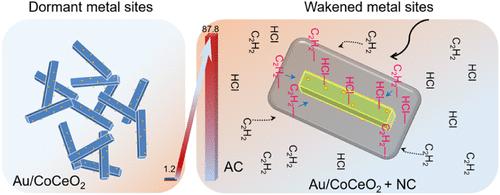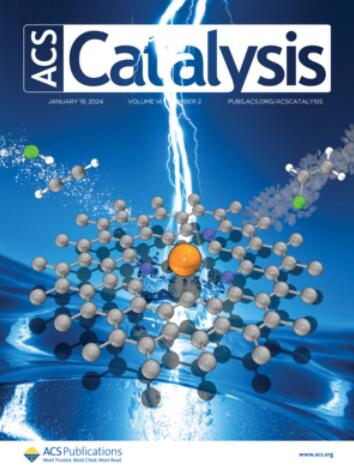Reversible Spillover Wakens Reactivity of Dormant Modular Hydrochlorination Catalysts
IF 11.3
1区 化学
Q1 CHEMISTRY, PHYSICAL
引用次数: 0
Abstract
Metals atomically anchored on oxides have actively realized ultimate atom efficiency. However, a “molecular cork” effect causes the intrinsically reactive sites to remain dormant in various important catalytic processes. Here, we report a strategy to waken dormant atomic Au on cobalt-doped CeO2 islands (Au/CoCeO2) that are typically recognized as barely active in acetylene hydrochlorination by precisely controlling reversible C2H2 spillover facilitated by porous carbon materials, igniting its reactivity of Au-oxo sites and enhanced stability. In this vein, the C2H2 coverage on the nitrogen-doped carbon (NC) surface reversibly spills over onto HCl-corked metal sites, uncorking the strongly bound HCl. The Au/CoCeO2 + NC system displays a 2 orders of magnitude higher activity than modular Au/CoCeO2 and obtains an enhanced catalytic activity and durability than the state-of-the-art catalyst, Au/NC. This contribution unveils a distinct Eley–Rideal-like mechanism that exists on the Au/CoCeO2 + NC system, exchanging the conventional Langmuir–Hinshelwood pathway dominated over Au/NC. Collectively, our findings reinforce the importance of taming the reaction pathways for advancing catalyst design.

求助全文
约1分钟内获得全文
求助全文
来源期刊

ACS Catalysis
CHEMISTRY, PHYSICAL-
CiteScore
20.80
自引率
6.20%
发文量
1253
审稿时长
1.5 months
期刊介绍:
ACS Catalysis is an esteemed journal that publishes original research in the fields of heterogeneous catalysis, molecular catalysis, and biocatalysis. It offers broad coverage across diverse areas such as life sciences, organometallics and synthesis, photochemistry and electrochemistry, drug discovery and synthesis, materials science, environmental protection, polymer discovery and synthesis, and energy and fuels.
The scope of the journal is to showcase innovative work in various aspects of catalysis. This includes new reactions and novel synthetic approaches utilizing known catalysts, the discovery or modification of new catalysts, elucidation of catalytic mechanisms through cutting-edge investigations, practical enhancements of existing processes, as well as conceptual advances in the field. Contributions to ACS Catalysis can encompass both experimental and theoretical research focused on catalytic molecules, macromolecules, and materials that exhibit catalytic turnover.
 求助内容:
求助内容: 应助结果提醒方式:
应助结果提醒方式:


